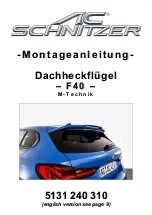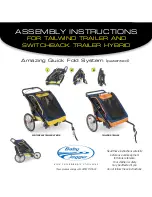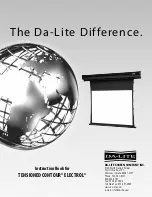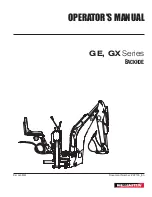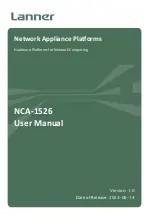
© 2007 - 2018 Thorlabs
5 Operating Instruction
57
5.2.4.2.1 WFS20 High-Speed Mode
The WFS20 instruments are based on a fast camera and can operate in Normal Mode and the
substantially faster High-Speed Mode. The WFS30 and WFS40 instruments are based on
slower cameras and operate at measurement speeds significantly lower than the WFS20 in-
struments operating in Normal Mode.
What is High-Speed Mode?
Normally, the complete spot field image is transmitted from the camera to the computer and the
wavefront analysis is performed by the WFS software. This method is speed-limited because of
the limited USB 2.0 bandwidth and the calculation speed limitations of the PC.
Compared to
Normal Mode
there are a number of differences in
High-Speed Mode
:
·
The spot field image is captured inside the camera and won't be transmitted via USB. In-
stead, the camera's FPGA, located in the control box, calculates the spot centroid co-
ordinates. Due to these internal calculations, the pupil center may shift slightly, when
switching from normal to high speed mode.
·
Only the calculated centroid positions are transmitted via USB to the GUI.
·
Due to the much lower transmitted data volume, the maximum measurement rate in-
creases.
·
Shifting the time-consuming centroid calculations to the much faster FPGA reduces the
CPU load and further calculations (wavefront, Zernike fit) accelerate.
The important
advantage
is a higher measurement speed, particularly at large camera resolu-
tions.
Along with that, some
restrictions and disadvantages
take place:
·
Centroid calculation windows are no longer dynamically positioned but are placed on a
semi-rigid grid.
·
This calculation grid will be configured each time you enter High-Speed Mode and re-
mains fixed afterwards.
·
The maximum wavefront dynamic range is lower because spot shifts are limited to the
fixed calculation windows. Therefore, there is an increased risk of incorrect measurements
due to camera saturation!
·
In High-Speed Mode, centroid position results become extremely sensitive to the camera's
black level and ambient light because all pixel intensities within the entire spot window
(width x height pixels) contribute to the final centroid result.
·
Further, low black level intensities will shift the result towards the window center. To get
rid of increased black level you have two options:
a)
Change the camera analogue black level: It can be lowered so that the pixels between
the spots become zero.
b) An adjustable ‘Noise Cut Level’ similar to that normal mode can be set when the camera
is in High-Speed Mode. Disable the 'Auto' option since it isn't available in
High -Speed Mode, anyway. The camera will subtract this level from
each pixel prior to the centroid calculation.
Summary of Contents for WFS20-14AR
Page 2: ...Copyright 2007 2018 Thorlabs Version Date 5 0 19 Jul 2018...
Page 15: ...2007 2018 Thorlabs 3 Coordinate Definitions 13 Wavefront Graph...
Page 106: ...2007 2018 Thorlabs 104 Wavefront Sensor Selectable camera image sizes for WFS40 Normal Mode...
Page 107: ...2007 2018 Thorlabs 8 Appendix 105 Selectable camera image sizes for WFS40 sub2 Mode...
Page 123: ...2007 2018 Thorlabs 8 Appendix 121 8 9 2 Drawing WFS20 5C...
Page 124: ...2007 2018 Thorlabs 122 Wavefront Sensor 8 9 3 Drawing WFS20 5C M...
Page 125: ...2007 2018 Thorlabs 8 Appendix 123 8 9 4 Drawing WFS20 7AR...
Page 126: ...2007 2018 Thorlabs 124 Wavefront Sensor 8 9 5 Drawing WFS20 7AR M...
Page 127: ...2007 2018 Thorlabs 8 Appendix 125 8 9 6 Drawing WFS20 14AR...
Page 128: ...2007 2018 Thorlabs 126 Wavefront Sensor 8 9 7 Drawing WFS20 14AR M...
Page 129: ...2007 2018 Thorlabs 8 Appendix 127 8 9 8 Drawing WFS20 Control Box...
Page 130: ...2007 2018 Thorlabs 128 Wavefront Sensor 8 9 9 Drawing WFS30 5C...
Page 131: ...2007 2018 Thorlabs 8 Appendix 129 8 9 10 Drawing WFS30 5C M...
Page 132: ...2007 2018 Thorlabs 130 Wavefront Sensor 8 9 11 Drawing WFS30 7AR...
Page 133: ...2007 2018 Thorlabs 8 Appendix 131 8 9 12 Drawing WFS30 7AR M...
Page 134: ...2007 2018 Thorlabs 132 Wavefront Sensor 8 9 13 Drawing WFS30 14AR...
Page 135: ...2007 2018 Thorlabs 8 Appendix 133 8 9 14 Drawing WFS30 14AR M...
Page 136: ...2007 2018 Thorlabs 134 Wavefront Sensor 8 9 15 Drawing WFS40 5C...
Page 137: ...2007 2018 Thorlabs 8 Appendix 135 8 9 16 Drawing WFS40 5C M...
Page 138: ...2007 2018 Thorlabs 136 Wavefront Sensor 8 9 17 Drawing WFS40 7AR...
Page 139: ...2007 2018 Thorlabs 8 Appendix 137 8 9 18 Drawing WFS40 7AR M...
Page 140: ...2007 2018 Thorlabs 138 Wavefront Sensor 8 9 19 Drawing WFS40 14AR...
Page 141: ...2007 2018 Thorlabs 8 Appendix 139 8 9 20 Drawing WFS40 14AR M...
Page 144: ...2007 2018 Thorlabs 142 Wavefront Sensor 8 11 Certifications and Compliances...
Page 145: ...2007 2018 Thorlabs 8 Appendix 143...
Page 153: ...www thorlabs com...
































